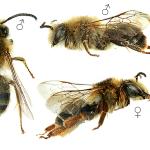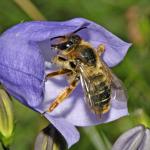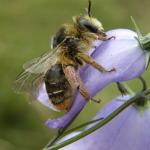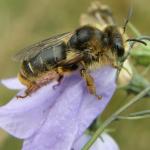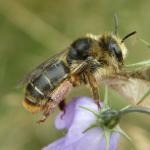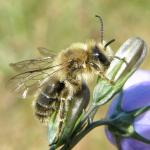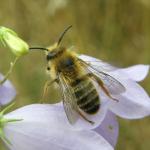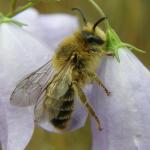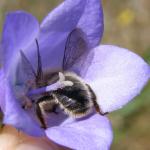Apis dichroa GMELIN 1790; Melitta chrysura KIRBY 1802
Melitta species generally have very narrow pollen preferences, either visiting a single species (monolectic) or a group of closely related species (oligolectic). The present species belongs to the second category.
Widely distributed in southern England, especially on chalky and limestone soils. The species has also been recorded from Wales and the Isle of Man. It is very rare in northern England and Scotland. The species was rediscovered at Grange-over-Sands, Westmorland, in July 1996 after an absence of records from that county of about fifty years (N Robinson, pers. comm.). A female M. haemorrhoidalis was collected at Cheswick Dunes, Northumberland, on 2nd August 1997 by M E Archer, and this seems to be the first record of the species from north-east England. Confirmed Scottish records are from Fifeshire in 1900 and East Perthshire before 1900. There are no records of this bee from Ireland or the Channel Islands. In Europe, the range extends from Fennoscandia south to Spain, and eastwards to Greece.
Not listed in Shirt (1987) or Falk (1991). The current distribution map shows that its status should be revised.
Mainly calcareous grassland and open rides in broad-leaved woodland on chalk.
Univoltine; mid July to late August (occasionally September).
The nest burrows are excavated in the soil. A small aggregation of burrows in a sandy hedge bank was observed in the Isle of Man (C O'Toole, pers. comm.).
Clustered bellflower (Campanula glomerata), nettle-leaved bellflower (C. trachelium), harebell (C. rotundifolia) and meadow crane's-bill (Geranium pratense). The bellflowers listed here are probably pollen sources, but the crane's-bill is likely to have been only a nectar source. Males have been observed visiting musk-mallow (Malva moschata), round-headed rampion (Phyteuma orbiculare) and hemp-agrimony (Eupatorium cannabinum). On overcast days specimens can sometimes be found sheltering in bellflowers (occasionally two bees in a flower).
None reported from Britain, though on the Continent Nomada flavopicta may be a cleptoparasite of it (Tengö & Bergstrom, 1976) and this association may exist in Britain.
Profile written: 1998
Proofed: January 2012


